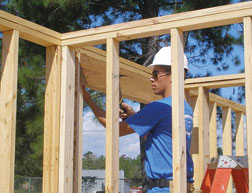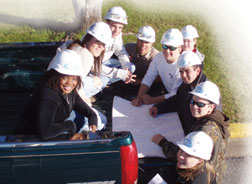
|
Acclaimed as a training model to spur construction careers, the Community High Okaloosa Institute for Career Education (CHOICE) in northwest Florida is attracting state and national attention. It prepares young people to step into skilled industry jobs or continue their studies through participating partners in higher education.
“This is one of the most significant strategies to come along in a long, long time—to get students at the early high-school level engaged in the real workforce,” says Wes Little, vice provost of the University of West Florida, Pensacola, a CHOICE partner. Okaloosa County schools, based in Fort Walton Beach, began CHOICE three years ago to prepare students for careers in growth industries such as construction, health care, information technology and aerospace.

CHOICE has three construction options.
|
CHOICE offers junior and senior high school students an alternative to regular classroom study. Participants spend three periods a day for 180 days each year immersed in a selected discipline. They also receive high-school credit, six hours of college credit and certification in their field of study.
CHOICE began through a university study commissioned by Okaloosa County to determine what area businesses thought about student preparation for the work world. About 87% of respondents said “we were doing a poor job and to do something different,” says Frank Fuller, Okaloosa’s assistant school district superintendent. “They said industry certification was the gold standard, and high school diplomas were like Confederate money.”
Okaloosa school officials approached the State Dept. of Education, but Fuller says the agency was concerned that something other than grades would be a measure of success. The district then turned to Workforce Florida Inc., the state’s work force policy organization, for research on high-paying, high-demand fields and guidance on how to structure training. That led to collaboration with economic development and business leaders.
Okaloosa also sought to develop a program that would offer national certification and opportunities for higher education. Construction participants earn certification from the National Center for Construction Education and Research, Gainesville. “This is offering students industry recognized credentials,” says Jamie Van Voorhis, NCCER’s director of work force development.
Students entering the two-year CHOICE: Construction Technology Institute enter one of three tracks—AutoDesk design for students interested in architecture or engineering; construction management for those aiming to become project managers, construction superintendents and field engineers; and construction trades for potential master carpenters, electricians, plumbers or welders.

|
Students use the latest software and technology for design and estimating. “We do a lot of hands-on, about 75% of what we do,” says Matt Clark, dean of the construction technology institute. “We build a smart house on both of our campuses and auction them off to the public.”
Students also must complete the U.S. Occupational Safety and Health Administration’s 10-hour safety course, as well as other certification-required exams. About half of the students earn a Florida Bright Futures Scholarship, which covers 75% of their college tuition, Clark says.

Program has had 600 high school participants since 2004, wih 60% continuing studies.
|
Lessons Learned
University provost Little calls the work experience absolutely critical and beneficial to the industry. He thinks it matures students and helps them to see how lessons taught in math, science and other courses apply in the real world. Some employers offer the students work-study opportunities and jobs. “It gives them a significant jump start or advantage,” Little says. “They are better prepared than a student going through a traditional high-school curriculum.” The district involves industry experts in designing CHOICE curricula.
“It was by far the best thing I could have done,” says Andrew Collins, a 2005 graduate, who now works for Williams Electric Co. in Fort Walton Beach, while attending community college with tuition reimbursement from his employer. He plans to become an engineer. “The AutoCAD certification I received saved me thousands and thousands of dollars, and it got me a great job doing AutoCAD every day.” A university study found that CHOICE graduates can earn about $300,000 more over their lifetimes than the average high-school graduate.
Jim Schaus, program manager for Williams Electric and a CHOICE board member, praises graduates’ technical skills. He finds that about half of the program’s graduates he hires become valued employees, compared to about 15% for typical “off-the-street” applicants. “To get my turnover from 15% to 50% is worthwhile,” Schaus says. “That is a real savings for us.”
Other industry partners include Hensel Phelps Construction Co. in Orlando and Haskell Co. in Jacksonville. “Our students are studying the same curriculum that Hensel Phelps, Brasfield & Gorrie and Haskell use to train incumbent workers,” Clark says. “It’s easy to place them on jobs.”
State officials are taking notice. “Now, the Dept. of Education is moving toward embracing the thing,” says Fuller.
In December, Workforce Florida also awarded Okaloosa schools a $1-million grant to provide technical assistance to other state school districts wanting to start or refocus existing career academies, develop standards for career education and research best practices. It already had awarded more than $2 million to other state school districts as of last year for CHOICE-type programs.
Jeff Scroggins, director of the CHOICE Institutes, says 19 districts have implemented them as of mid-April. He also has been contacted by districts from across the U.S. “To replicate, you need to find out what is important in your area and what the growth demand needs are,” he says. “Then use the CHOICE model, with national industry credentialing and the articulation agreements with post-secondary [education partners].”
 "Opportunities are not promoted aggressively, early enough. Programs like this offer students an alternate path" "Opportunities are not promoted aggressively, early enough. Programs like this offer students an alternate path" — Gerald Sprentall, Intel and Curt
|
The approach is appealing to owners concerned about the future construction work force. “Career opportunities in construction are not promoted aggressively, early enough,” says Gerald Sprentall, CSC construction manager for Intel Corp., Chandler, Ariz., and co-chair of the work force development and industrial relations committee of the Construction Users Round Table. “Programs like CHOICE offer students an alternate path. Expanding awareness...remains an important component of the very challenging task of recruitment. ”

Students gain NCCER certification.
|
Formula for Success
Others agree. “If a career academy is implemented properly, it can be very successful,” says Carol Berrigan, director of industry infrastructure for the Nuclear Energy Institute, Washington, D.C. “We’re concerned about having the right people with the right skills in the market and are trying to identify model programs.” She says the trade association is partnering with the Center for Energy Workforce Development, a nonprofit utility group coalition, to develop an energy and construction-related career academy in the Washington area.
As for Florida’s effort, CHOICE officials say that some 600 students have participated in the construction institute, with about 60% of graduates continuing studies at a technical school, community college or university. Not all decide to stay in the industry, but Clark says they learn early about a career fit and can use scholarships to pursue other options.
Other students become passionate about the field. “They are focused and goal oriented to make a career out of construction, and that’s valuable to the construction companies,” Clark says. “They know they can take these kids and invest more training in them, and they will stick.”


Post a comment to this article
Report Abusive Comment